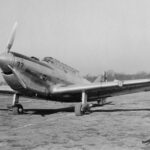YA-19 38-554
Test bed Vultee YA-19A
Vultee YA-19A 2
Vultee V-11 China
Vultee YA-19A
Vultee V-11GB
Vultee V-11 China
Vultee V-11G
Derived from Gerald Vultee’s V-1 transport design of 1934, the Cyclone-powered V-11 took to the skies for the first time in September 1935. Despite its sleek and modern all-metal construction, featuring retractable landing gear, this aircraft was intended to compete with Northrop’s A-17 series. Surprisingly, even before the Army showed sufficient interest to place an order for seven service test aircraft in June 1938, over 100 examples had already been sold to foreign air forces abroad. The service test models, designated as YA-19, were equipped with supercharged Twin-Wasp engines instead of Cyclones. All seven YA-19s were delivered by the middle of 1939. However, by that time, the Army’s focus had shifted towards twin-engine attack aircraft, causing the YA-19 to miss full-scale production, despite its acceptable performance. Two of the YA-19s were later utilized as engine testbeds: the XA-19A, fitted with a 1,200-hp Lycoming O-2130 inline engine, and the XA-19B, tested with a powerful 1,800-hp Pratt & Whitney R-2800 engine. The remaining five YA-19s initially served at March Field but were subsequently transferred to the Canal Zone, where they found use with military attaches at nearby American embassies.







